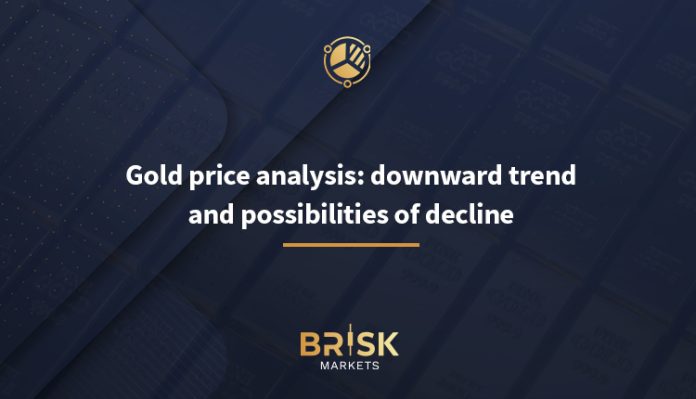
Gold is one of the oldest metallic elements used as a means of trade and investment. Gold is very popular among investors because of its stable value over time and it being a safe haven in difficult economic times. In this article, we will analyze the price of gold and the expected scenarios for its movement in the coming period.
Gold price analysis: Currently, the gold price is witnessing negative trading as it gradually heads towards the important support level at $2260.60. This level represents a 50% Fibonacci retracement of the rise in the price of gold that was measured from $1,984.16 to $2,431.44. If this level is broken, we can expect the bearish wave to continue and reach $2207.80 as the next target.
It is noted that the price forms lower peaks, which enhances the chances of continuing the decline and achieving more negative targets. In addition, the 50-day moving average constitutes continuous negative pressure against the price, which increases the possibility of a continuation of the decline.
Expected scenario: Based on technical analysis and fundamental factors, it appears that gold may continue to trade in a bearish direction in the coming period. The price may continue to decline towards the above-mentioned support levels, especially in light of the continued negative pressures facing the financial markets.
However, market factors, such as geopolitical developments and changes in monetary policies, should be carefully monitored, as these factors can affect gold price trends.
Ultimately, investors should be careful and make appropriate decisions based on a comprehensive analysis of the current situation and future expectations of the gold market. Given the previous analysis, we can expect a trading range for the gold price in the coming period between the identified support level and resistance level.
Rising trends in the price of gold since the beginning of 2016
Support Level at $2260.00: This is a vital level that is expected to provide support to the gold price. If the price can hold above this level, this could lead to continuation of sideways trading or even a reversal of the uptrend.
– Resistance level at $2,305.00: represents a level that is considered difficult for the price of gold to overcome. If this level is exceeded, this may indicate a continuation of the upward movement or enhanced upside opportunities in the medium term. Therefore, the expected trading range for gold price can be summarized between the support level at $2260.00 and the resistance level at $2305.00. You should monitor price movement within this range and look for confirmatory signals of a potential trend before making trading decisions.
The upward trends in the price of gold have resumed since the beginning of the year 2016, as signs of the actual upward wave began to appear since the beginning of the last quarter of the year 2018. The price of gold witnessed the achievement of new historical levels, as it exceeded the barrier of two thousand dollars per ounce for the first time after the middle of the year 2020. Despite The temporary downward corrections that the price of gold witnessed, but it was able to make a noticeable recovery and a new rise, in which it reached the current levels and recorded new historical peaks estimated at $2,430.00 per ounce.
Gold price forecasts in 2024 and 2025: Given the current conditions and historical trends of the gold price, the upward trend can be expected to continue in the long term. The price of gold may continue to achieve new highs in the coming years, given the economic and political factors that support increased demand for safe havens such as gold.
Recent developments in the gold market
Demand for safe havens is likely to remain strong, supporting a continued rise in gold prices. Therefore, upward trend in the price of gold can be expected to continue in 2024 and 2025, with the possibility of achieving new highs that exceed the historical levels recorded in previous years.
Recent developments in the gold market show a decline in its prices, reaching a four-week low. This decline is attributed to abandoning trading above psychological barrier at $2,300, under pressure from rising US dollar levels.
This development comes ahead of the release of important economic data from the United States, in addition to the Federal Reserve’s announcement of the results of its regular monetary policy meeting. These data and results are expected to provide new pricing on possibilities of a cut in US interest rates during this year, which may increase negative pressures on the prices of gold and other non-yielding assets.
These factors reflect the challenges that gold prices are currently facing, and reinforce the need to follow upcoming developments in the economic and political markets to understand potential trends of gold prices in the near future.
A price look at gold prices reveals a decline in its value today by about 0.2%, reaching $2,281.74, the lowest level since last April 5. Trading began at an opening level of $2,286.13, and reached a high of $2,293.30.
Regarding price settlement on Tuesday, the precious metal saw a decline of 2.15%, which was the second daily loss in a row, and the largest daily loss since last April 22. This decline is attributed to rising pressure on the dollar after the release of strong economic data from the United States.
During the month of April, gold prices witnessed a rise of 2.35%, which was the third monthly gain in a row
Gold is a tool to hedge against inflation
Citibank Group expects the price of gold to reach $3,000 per ounce within six to eight months
Next ten days. Gold is considered a hedge against inflation, and shows good performance in periods of economic uncertainty, as investors move towards lower-risk assets.
Gold prices recorded their highest level ever at $2,431.55 per ounce last Friday, April 12, which reflects the increasing demand for this safe haven in light of unstable economic conditions.














